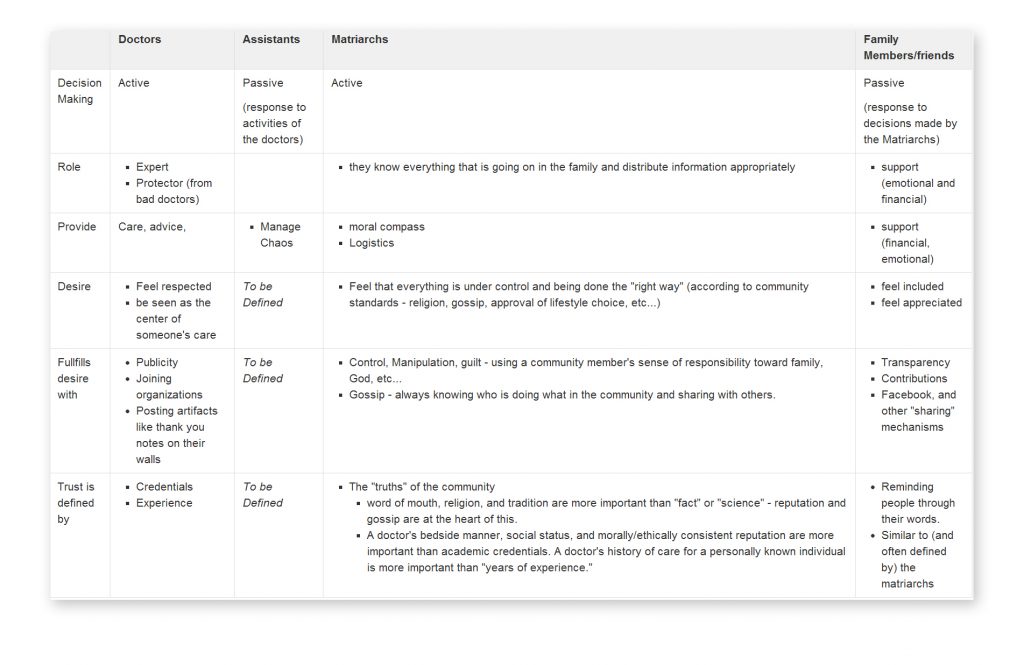CASE STUDY: MEDICSANA – BRAND
The following has been copied and pasted out of our confluence wiki page where we amassed and synthesized our insights from our remittance sender interviews and our doctor interviews. These insights drove the development of our business plan, brand strategy and the application design.
“Being a doctor is a romantic science that requires the human touch”
– Dr. Morales
Guadalajara, México
Overview
Tenets are defined as: “An opinion, doctrine, or principle held as being true by a person or especially by an organization.”
Brand Tenets are principles that our brand holds that help guide our decisions in value proposition, product set, and voice.
We have pulled these tenets together from interviews with our target customers. By understanding not only their needs, but their feelings and the means by which they define themselves in the context of their goals, work, and community, we can more easily craft solutions that will be truly meaningful to them.
The core of our brand is Community
Our research shows that across the four roles that we will engage – Doctors, Assistants, Matriarchs, and payers, community dynamics are key. These were expressed in different ways, but common themes across all of our interviews centered around the key components of a community:
1. Roles
People have different roles, but everyone has one and is expected to play it.
- Roles divide labor within a community
- Certain roles are responsible for knowledge (Doctors), certain roles for organization and logistics within a community (Matriarchs)
- Examples:
- In every family, a “Matriarch” keeps the family in order. She is the central hub of information in the family and usually plays an active role in coordinating family activity.
- People who have moved to the states (or otherwise have jobs with more money) feel that they are providers for the family. They want to continue to feel connected with the family, but also a feeling of appreciation or gratitude for what they provide.
- Doctors have a lot of pride in their background because they have a lot of responsibility. They know that bedside manner and human reputation is the most important way to maintain patients and get new ones – but it is their credentials that supports their prognosis.
2. A sense of who is “in” and “out”
This is how the community protects it’s members from uncertainty.
- Some people in the community are gatekeepers – it is their job (explicitly or implicitly) to protect the passive members
- Examples:
- Most doctors differentiate between other doctors who are “trustworthy” and those who will charge patients for more treatment than they can afford. These doctors are proud of the role that they play in directing their patients only to trusted specialists.
3. A safety net for it’s members
People “in” the community know that they can rely on the community to help them in their time of need.
- Different communities have customs for how long or often a safety net can be used by an individual, but there is always a sense of “From each according to her ability, to each according to her need” in small communities. Informal tallies are kept about how much a member of a community has “taken” and “given”
- Examples:
- Doctors will give discounts to patients based on the knowledge of their situation.
- Matriarchs know how much money members of their family make and expect a contribution relative to a person’s means.
4. “Truth”
A community shares a set of customs, morals, and ethics.
- A person’s standing in the community is a measure against the morals and ethics of the community.
- There is a natural friction between Doctors – who’s sense of “truth” often comes from science, and their patients who often believe in homeopathic medicine, crystals, and any number of other traditional home remedies. Doctors are well aware of this and have ways to cope with it.
- Examples:
- Even members of a family that have fallen out contribute funds because of a sense of familial or religious responsibility
- For many, homeopathic or home remedies are just as valid as medical treatment
- Examples:
MedicSana is a catalyst for communities that already exist
Our product is NOT a community. The community already exists, it is up to our product to be accepted by this community and help it communicate easier, not “create” it. MedicSana offers a way for people to be better parts of the community by:
- Empowering the nodes:
- I am responsible for my health records (and I feel a sense of control because I know where they are)
- I am able to manage things for my dependents because I can see what is happening.
- Re-enforcing and expanding the trust network
- Strengthening the communication channels
- Allowing word-of-mouth reputation to expand beyond what is traditionally possible.
The contents of this box are important because they help me be a better part of the community by:
- Gossip: a safe, easy way to validate community members based on reputation
- My reputation grows when people see me as a central node of trust
- Responsibility through organization
Thoughts on Exclusivity
Exclusivity is an important factor in our brand, but I think we need to be careful about what it means to us.
- Exclusivity IS: “as a trust network, someone has vouched for your reputation so you received an invitation”
- Exclusivity IS NOT: “Only special people get this, you’re special, so you get it.”
- Exclusivity is less about Public-facing reputations and more about micro-trust.
Back to:
- The MedicSana Project Homepage
- The MedicSana Brand
- The MedicSana App Design
- The Research Process I: Remitters in the US
- The Research Process II: Doctors in Latin America
Read More
Read more about the MedicSana project, other design case studies, or more about me on my homepage.
